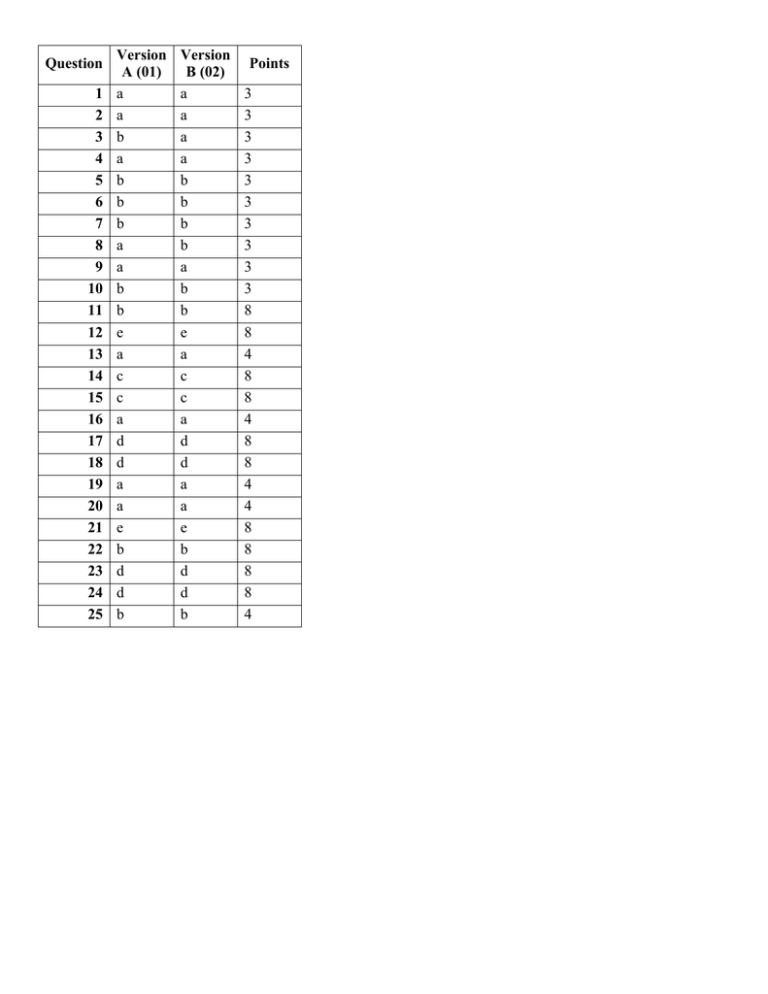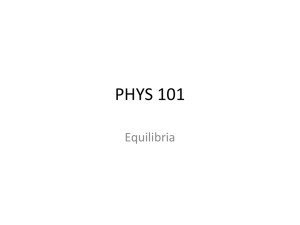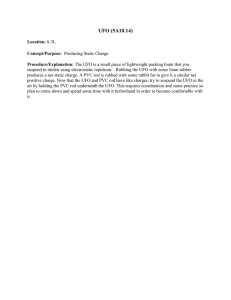Question Version A (01) Version B (02) Points 1 a a 3 2 a a 3 3 b a 3
advertisement

Question 1 2 3 4 5 6 7 8 9 10 11 12 13 14 15 16 17 18 19 20 21 22 23 24 25 Version A (01) a a b a b b b a a b b e a c c a d d a a e b d d b Version B (02) a a a a b b b b a b b e a c c a d d a a e b d d b Points 3 3 3 3 3 3 3 3 3 3 8 8 4 8 8 4 8 8 4 4 8 8 8 8 4 True/False Section: each question worth 3 points. 1. Two solid balls with different mass and different radii are released from rest simultaneously at the top of a ramp. The balls then roll down the ramp without slipping (neglect air resistance). The two balls reach the bottom of the ramp at the same time. a. True b. False 2. A wheel is spinning clockwise and slowing down. The wheel’s angular velocity and angular acceleration vectors point in opposite directions. a. True b. False 3. A wheel is spinning with constant angular acceleration. The net torque on the wheel is zero. a. True b. False 4. Two cars of equal mass are traveling at the same speed. One car crashes into a wall and stops suddenly. The other car applies its brakes and gradually slows to a stop. The impulse imparted to each car while stopping is the same in magnitude. a. True b. False 5. Consider two parallel rotation axes, only one of which passes through the center of mass of a particular object. The object’s moment of inertia around the center-of-mass axis is larger than its moment of inertia around the other axis. a. True b. False 6. Two balls of equal mass are dropped from the same initial height and bounce off the ground to the same final height. During the bounce, the first ball is in contact with the ground for twice as long as the second. The average force exerted by the ground is twice as much for the first ball than the second. a. True b. False 7. Newton’s cradle is a toy with five steel balls suspended vertically by strings in a single line. Collisions between the balls are completely elastic. When one ball is lifted to the side and released two balls swing outward on the other side after the collision. a. True b. False 8. A bomb that is initially stationary will have zero net momentum immediately after it explodes. a. True b. False 9. A massive bus and a light bullet have the same kinetic energy (not equal to zero). The bus has more momentum. a. True b. False 10. Before a collision, the total kinetic energy of two isolated objects is greater than zero. After the objects collide, the total kinetic energy cannot be zero. a. True b. False Scenario 1: This simple experimental setup can be used to measure the moment of inertia of a rolling object. The object shown has a round facet, which allows it to roll smoothly down the ramp without slipping. The specific distribution of mass within the object is unknown: its moment of inertia is not necessarily one with which we are already familiar. Use the following values: 𝐻=1m; 𝑀 = 5 kg; 𝑅 = 5 cm 11. [MC5 – select up to 2 answers] The object starts from rest at height 𝐻. When it reaches the bottom of the ramp, the object continues to roll without slipping with constant angular speed, 𝜔 = 70 rad/s. What is the moment of inertia of the object? a. 𝐼 = 6.0 × 10/0 kg-m2 b. 𝐼 = 7.5 × 10/0 kg-m2 1 2 I! + 2 1 = I! 2 + 2 2M gH I= M gH = c. 𝐼 = 8.3 × 10/0 kg-m2 d. 𝐼 = 12.5 × 10/0 kg-m2 e. 𝐼 = 25 × 10/0 kg-m2 = 2M gH !2 1 MV 2 2 1 M ! 2 R2 2 M ! 2 R2 !2 M R2 12. [MC5 – select up to 2 answers] A different object has the same mass and radius, but a different moment of inertia, 𝐼 = 5.0 × 10/0 kg-m2. This object is released from rest from the same height, 𝐻, and it rolls without slipping down the ramp. What is the translational speed of the object at the bottom of the ramp? a. 𝑉56 = 1.2 m/s b. 𝑉56 = 1.9 m/s c. 𝑉56 = 2.8 m/s d. 𝑉56 = 3.2 m/s e. 𝑉56 = 3.7 m/s 1 2 1 I! + M V 2 2 2 2 1 V 1 = I 2 + MV 2 2 R✓ 2 ◆ 2 V I = +M 2 R2 s 2M gH V = I R2 + M M gH = 13. [MC3 – select only 1 answer] If a particular object rolls without slipping down a steeper ramp (larger 𝜃) from the same height 𝐻, how does its translational speed at the bottom of the ramp change? a. The translation speed in both cases will be the same. b. The translational speed will be larger for the steeper ramp. c. The translational speed will be smaller for the steeper ramp. Scenario 2: 𝑔 An unidentified flying object (UFO) hovers in the sky above Salt Lake City. Initially, the UFO is not spinning; at a particular time, it starts to spin and the angular speed increases until reaching a particular value, after which it stays constant. Since it is large and hovering at a low altitude, we cannot neglect drag (air resistance), which always acts to slow the UFO’s angular speed. The torque due to drag is linearly proportional to the UFO’s angular speed: 𝜏:;<= = 𝜅𝜔, where 𝜅 is a proportionality constant (with the correct units) and 𝜔 is the angular speed of the spinning UFO, which depends on time. 14. [MC5 – select up to 2 answers] To obtain a constant angular speed, rotation thrusters located a distance 𝑅 from the axis of rotation exert a total force, 𝐹@A@ , in a direction perpendicular to a radial line extending from the axis of rotation to the outer rim of the UFO. If an observer on the ground measures a time 𝑇 for one rotation of the UFO, what is the magnitude of 𝐹@A@ when it is rotating at a constant speed? a. 𝐹@A@ = 𝑇 𝜅 2𝜋 𝑅 b. 𝐹@A@ = 2𝜋 𝑅 𝑇 𝜅 c. 𝐹@A@ = 2𝜋 𝜅 𝑇 𝑅 d. 𝐹@A@ e. 𝐹@A@ ⌃⌧ = IUFO ↵ =0 =) ⌧thrust = ⌧drag 𝑇 𝑅 = 2𝜋 𝜅 𝜋 𝜅 = 2𝑇 𝑅 Ftot R = ! Ftot = ! (2⇡/T ) 2⇡ = = R R T R 15. [MC5 – select up to 2 answers] An alien inside the UFO sits at 𝑅/2 (half way between the UFO’s axis of rotation and its outer rim). How fast does the UFO need to rotate so that the alien experiences a centripetal force equal to its weight? a. 𝜔 = 4𝑔 𝑅 b. 𝜔 = 4𝜋𝑔 𝑅 c. 𝜔 = 2𝑔 𝑅 d. 𝜔 = 𝑔 2𝑅 e. 𝜔 = 2𝜋𝑔 𝑅 Fcent = macent R mg = m! 2 r 2 2g != R 16. [MC3 – select only 1 answer] All the aliens inside the UFO move from near the axis of rotation to near the UFO’s outer radius, but the UFO continues to rotate with the same angular speed. When this happens: a. The kinetic energy increases. b. The kinetic energy decreases. c. The kinetic energy stays the same. Scenario 3: A window cleaner stands on a scaffold suspended from the top of a tall building. The scaffold consists of a wooden plank suspended by four ropes, one on each corner. There is also a large bucket of water on the scaffold. The window cleaner can stand anywhere on the scaffold and can also place the bucket at any location. Use the following values: 𝐿=3m 𝑀H<I = 85 kg 𝑀JKLMN@ = 20 kg 𝑀OP<IM = 120 kg 17. [MC5 – select up to 2 answers] The man stands 1 meter from the left edge of the scaffold and he places the bucket 0.5 meters from the right edge. Considering the two ropes on the left side of the scaffold, what is the average of the tension in each of these two ropes? a. 120 N b. 96 N c. 72 N Axis of rotation at right end of plank: 2TL (L) d. 60 N e. 48 N Note: As discussed during the exam, the answer choices above were mistakenly NOT multiplied by “g” and are therefore erroneous. This was corrected during the exam. Mman (L 1)g Mplank (L/2)g Mbucket (0.5)g = 0 1) + Mplank (1.5) + Mbucket (0.5)] g 6 [85(2) + 120(1.5) + 20(0.5)] g = 6 = 60g N TL = [Mman (3 18. [MC5 – select up to 2 answers] With the bucket in the same location as above, where should the man stand to equalize the tension in all four ropes? (Assume the bucket and man are both positioned along a line midway between the front and back edges of the plank.) a. 0.24 m from left edge b. 0.48 m from left edge c. 0.76 m from left edge Axis of rotation at center of plank: 2TL (L/2) Mman g(d) 2TR (L/2) + Mbucket g(1) = 0 d. 1.26 m from left edge 2TL = 2TR e. 1.38 m from left edge =) Mman (d) = Mbucket (1) Mbucket 20 d= = Mman 85 = 24 cm 19. [MC3 – select only 1 answer] Now the man stands at the center of the plank and the bucket is still 0.5 meters from the right edge. Suddenly, a bird knocks the bucket and all its water off the scaffold. How does the tension in the ropes change after the bird knocks over the bucket? a. The tension in all four ropes decreases. b. The tension in the right-hand ropes decreases, but the tension in the left-hand ropes stays the same. c. The tension in the right-hand ropes decreases, but the tension in the left-hand ropes increases. Scenario 4: A uniform rod is attached to a wall with a frictionless pivot at one end and a horizontal string attached to the other end. Initially, the rod makes an angle 𝜃 with respect to the wall. Use the following value: θ 𝐿=3m 20. [MC3 – select only 1 answer] How does the tension in the string compare for two different values of 𝜃: 10° and 80° ? (The string is readjusted to horizontal for each value of 𝜃.) 𝑔 a. As 𝜃 increases, tension also increases b. As 𝜃 increases, tension decreases c. As 𝜃 increases, tension remains constant 21. [MC5 – select up to 2 answers] When 𝜃 = 30°, the tension in the string is 𝑇 = 170 N. What is the mass of the rod? a. 20 kg b. 30 kg c. 35 kg d. 50 kg T (L cos ✓) e. 60 kg X ⌧ =0 L sin ✓) = 0 2 Mg sin ✓ = T cos ✓ 2 2T cos ✓ M= g sin ✓ M g( 22. [MC5 – select up to 2 answers] The rod is initially held at 𝜃 = 30° as above. The string is then cut and the rod begins to rotate. When the rod passes through horizontal (𝜃 = 90°), what is its angular speed? a. 𝜔 = 2.2 rad/s b. 𝜔 = 2.9 rad/s c. 𝜔 = 3.5 rad/s d. 𝜔 = 4.1 rad/s e. 𝜔 = 5.8 rad/s 1 2 I! 2 r 2M gH != I s r 2M gH 6gH = = 1 2 L2 3ML r r 6g(L/2) cos ✓ 3g cos ✓ = = L2 L M gH = Scenario 5: In bowling, a heavy ball (7.5 kg) travels down a horizontal lane toward 10 pins (1.5 kg each) arranged in a triangle. The ball collides elastically head on with the first pin at the point of the triangle. 23. [MC5 – select up to 2 answers] A player rolls the ball with speed 𝑣 = 7.5 m/s straight down the lane toward the first pin (at the point of the triangle). What is the speed of the first pin immediately after being hit by the ball (before it hits other pins)? a. 5 m/s b. 6.25 m/s c. 10 m/s d. 12.5 m/s e. 15 m/s 24. [MC5 – select up to 2 answers] As the ball passes through the pins, it collides with 3 (and only 3) separate pins in close succession (neglect time between collisions) and its speed decreases from 7.5 m/s (before hitting the first pin) to 2.2 m/s (after hitting the third pin). This entire triple collision takes approximately 0.2 seconds in total. Estimate the average force exerted on the ball by each pin during each collision assuming that each collision takes the same amount of time: a. 8 N b. 40 N c. 66 N d. 200 N e. 600 N Since the ball collides consecutively with each pin, this is the average force for each of the three collisions. Each collision takes 1/3 of the total time, accounting for 1/3 of the total impulse. 25. [MC3 – select only 1 answer] When the player initially releases the ball, it slides down the lane for some time and then eventually begins to roll without sliding. What equation below correctly predicts the translational speed of the ball when it begins to roll without sliding? 1 2 a. 𝑉J<PP = 𝜔J<PP 𝑅J<PP b. 𝑉J<PP = 𝜔J<PP 𝑅J<PP c. 𝑉J<PP = 2 𝜔J<PP 𝑅J<PP


